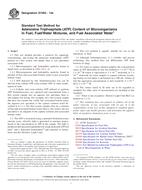Potřebujeme váš souhlas k využití jednotlivých dat, aby se vám mimo jiné mohly ukazovat informace týkající se vašich zájmů. Souhlas udělíte kliknutím na tlačítko „OK“.
ASTM D7463-14a
Standard Test Method for Adenosine Triphosphate (ATP) Content of Microorganisms in Fuel, Fuel/Water Mixtures, and Fuel Associated Water (Includes all amendments And changes 12/31/2015).
Automaticky přeložený název:
Standardní zkušební metoda pro Adenosintrifosfát (ATP) Obsah mikroorganismů v palivu, Fuel / voda, a palivo Associated Water
NORMA vydána dne 1.6.2014
Informace o normě:
Označení normy: ASTM D7463-14a
Poznámka: NEPLATNÁ
Datum vydání normy: 1.6.2014
Kód zboží: NS-38517
Počet stran: 8
Přibližná hmotnost: 24 g (0.05 liber)
Země: Americká technická norma
Kategorie: Technické normy ASTM
Anotace textu normy ASTM D7463-14a :
Keywords:
adenosine triphosphate, ATP, bacteria, biocontamination, biodeterioration, biomass, fuel, fungi, microbe, microbiology, ICS Number Code 07.100.99 (Other standards related to microbiology), 75.160.20 (Liquid fuels)
Doplňující informace
| Significance and Use | ||||||||||||||||||
|
5.1 This test method measures the concentration of ATP present in the sample. ATP is a constituent of all living cells including bacteria and fungi. Consequently, the presence of ATP is a reliable indicator of microbial contamination in fuel systems. ATP is not associated with matter of non-biological origin. 5.2 This test method differs from Test Method D4012 as follows: 5.2.1 By providing for the rapid determination of ATP present in a fuel (petroleum) sample, a fuel and water mixture sample, fuel-associated bottom water sample, and extracellular ATP freely available in the fuel or aqueous sample matrix; 5.2.2 By providing for a method to capture, extract, and quantify ATP using self-contained test device and luminometer; 5.2.3 By providing a method of quantifying ATP present in fuel or water matrices in generally less than 10 min; and 5.2.4 By providing for the rapid separation of the ATP from chemical interferences that have previously prevented the use of ATP determinations in complex fluids containing hydrocarbons and other organic molecules. 5.3 This test method does not require the use of hazardous materials and does not generate biohazard waste. 5.4 This test method can be used to estimate viable microbial biomass, to evaluate the efficacy of antimicrobial pesticides, and to monitor microbial contamination in fuel storage and distribution systems. |
||||||||||||||||||
| 1. Scope | ||||||||||||||||||
|
1.1 This test method provides a protocol for capturing, concentrating, and testing the adenosine triphosphate (ATP) present in a fuel system sub-sample (that is, test specimen) associated with: 1.1.1 Microorganisms and hydrophilic particles found in liquid fuels as described in Table X6.1, or 1.1.2 Microorganisms and hydrophilic particles found in mixture of fuel and associated bottom water or just associated bottom water. 1.1.3 ATP detected by this bioluminescence test can be derived from cellular ATP, extra-cellular ATP, or some combination of both. 1.1.4 Cellular and extra-cellular ATP utilized to perform ATP bioluminescence are captured and concentrated from a fuel system sample into an aqueous test specimen (that is, sub-sample) for testing. For example, for a fuel system sample that does not contain any visible fuel associated bottom water, the aqueous test specimen is the capture solution itself described in 8.2.1.1. For fuel system samples that are a mixture of fuel and associated bottom water (that is, free water), the test specimen is an aliquant of the capture solution and associated bottom water. 1.2 The ATP is measured using a patented bioluminescence enzyme assay, whereby light is generated in amounts proportional to the concentration of ATP in the sample. The light is produced and measured quantitatively using dedicated ATP test pens1.3 This test method is equally suitable for use in the laboratory or field. 1.4 Although bioluminescence is a reliable and proven technology, this method does not differentiate ATP from bacteria or fungi. 1.5 For water or capture solution samples, the concentration range of ATP detectable by this test method is 1 × 10–11 M to 3 × 10–8 M which is equivalent to 1 × 10–14 moles/mL to 3 × 10–11 moles/mL for water samples or capture solution. Assuming testing on fuel phase is performed on a 500 mL volume of fuel the equivalent concentrations is fuel would be: 6 × 10–11 M to 2 × 10–14 M. 1.6 The values stated in SI units are to be regarded as standard. No other units of measurement are included in this standard. 1.6.1 There is one exception—Relative Light Unit (RLU) as defined in 3.1.19. 1.7 This standard does not purport to address all of the safety concerns, if any, associated with its use. It is the responsibility of the user of this standard to establish appropriate safety and health practices and determine the applicability of regulatory limitations prior to use. |
||||||||||||||||||
| 2. Referenced Documents | ||||||||||||||||||
|
Odebírejte informace o nově vydaných normách ZDARMA:
Chcete pravidelně odebírat informace o nově vycházejících normách z celého světa a to zcela zdarma?
Přihlašte se k odběru. Vše je velice jednoduché a absolutně ZDARMA.
Na výběr máte vydavatele z celého světa.




 Cookies
Cookies
